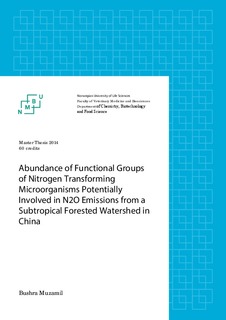| dc.description.abstract | In this study, we investigated N-cycling processes and N2O emissions along a hillslope (HS) and a hydrologically connected groundwater discharge zone (GDZ) in a subtropical forest ecosystem in southwest China, Tieshanping (TSP). The two landscape elements HS and GDZ differ fundamentally in eco-hydrological conditions, soil texture, organic carbon supply, pH (dominated by acid soils pH 4.0 - 4.5) and NO3- concentration. The area has received high levels of long-distance transported nitrogenous compounds for several decades. Earlier studies by our research group showed high N2O emissions from the investigated plots, The highest emissions were measured from the hilslope (HS), while the groundwater discharge zone had lower emissions, possibly due to complete denitrification taking place in this zone where anoxic conditions prevailed over longer periods than in the HS. Accumulation of nitrite was also shown, and it was speculated that nitrite oxidation was retarded compared to ammonia oxidation.
For this study Soil samples were collected from Tieshanping (TSP). DNA was extracted from the soil samples. Cloning was done to make plasmids, which were used as standards for the primers for each corresponding gene. Quantitative PCR was used to quantify the genes; by quantifying the genes, abundance of functional members at different sampling sites was revealed. In addition to this a microcosm experiment was performed, to analyze the denitrification activity from both HS and the GDZ soil samples.
In the present study, I quantified functional genes that are involved in the nitrogen cycle, including genes coding for ammoniam oxidation (amoA of ammonia oxidizing bacteria; AOB and archaea, AOA); nitrite oxidation (nxrB),and denitrification (nirK, nirS, nosZ). 16S rRNA abundance was assessed as a general marker for bacterial abundance. In addition, sulphate reducing bacteria (dsrA) were quantified. Aim of this study was to see if there is correlation between abundance of N-cycle genes and N-transformation rates. It was hypothesized that nitrous oxide reductase (N2OR) was present at HS but was not expressed due to oxic anoxic transitions while the other enzymes (NIR, NOR) are not influenced. Nitrite oxidation was retarded in HS samples, for this reason it is assumed that amoA (ammonia oxidizers) abundance will be higher than nxrB (nitrite oxidizers) abundance in samples where nitrite accumulates. Archaeal ammonia oxidisers will dominate (higher abundance) while there will be lower amounts of bacterial ammonia oxidisers due to low pH in this soil. GDZ has low organic material, and may not provide enough electrons for denitrification. It is hypothesized that the reductive force can be provided by the sulphate reducers.
All genes showed highest abundance per gram soil in the heavily disturbed GDZ (formerly cultivated terraces), despite lower soil organic carbon content (1-4% w/w as opposed to 10-20% w/w in HS topsoil). Archaeal ammonia oxidizers (AOA) were more abundant than bacterial ammonia oxidizers (AOB) which could be due to the low pH of these soils The results of the microcosm experiment (semi-automated robotic incubation system) were in accordance with the denitrification results observed from the molecular studies i.e. GDZ has high denitrification activity than HS (normalized to Carbon content).
The reason for high abundance of genes in GDZ could be due to the presence stable anoxic conditions. N2OR is expressed under the stable anoxic conditions leading to lower N2O emission. Additional factors causing lower N2O emissions from the GDZ may be the higher soil pH (4.5 at GDZ versus 4.0 at the HS). We can conclude that the GDZ is the sink, where the microbial communities are more abundant. | nb_NO |
